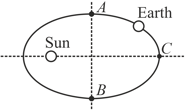Kepler's Laws of Planetary Motion
Kepler's Laws of Planetary Motion: Overview
This topic covers concepts, such as, Kepler's Laws of Planetary Motion, Kepler's Law of Orbits, Kepler's Law of Areas, Kepler's Law of Periods, Explanation of Kepler's Laws & Areal Velocity of Planets etc.
Important Questions on Kepler's Laws of Planetary Motion
A planet of mass is in an elliptical orbit about the sun with an orbital period . If be the area of orbit, then its angular momentum would be
A satellite revolves around a planet in circular orbit of radius (much larger than the radius of the planet) with a time period of revolution If the satellite is stopped and then released in its orbit (Assume that the satellite experiences gravitational force due to the planet only).
If a new planet is discovered rotating around the sun with the orbital radius double that of earth, then what will be its time period approximated to the nearest integer (in earth's days)?
(Take )
A planet is orbiting a star. Due to some inexplicable reason, the star’s gravity suddenly vanishes, after which planet moves in a straight line. Mark the correct statement.
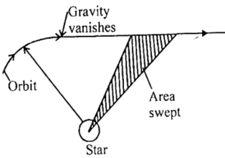
Assertion: Areal speed of planets moving around the sun remains constant.
Reason: Gravitational force between planet and sun provides required centripetal force to the planet for revolution around the sun.
Figure shows elliptical orbit of a planet about the sun .The shaded are is twice the shaded area . If is the time for the planet to move from and and is the time to move from and , then .
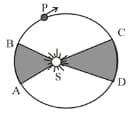
Kepler's second Law states that the line connecting the planet and the Sun covers unequal areas in equal intervals of time.
A planet moving around the sun sweeps area in days, in days and in days, then find the relation between , and .
According to Kepler's second law of planetary motion, the areal velocity of a planet revolving around the sun
State Kepler's second law of planetary motion.
What do you understand by the areal velocity of a planet?
Assume that the earth moves around the sun in a circular orbit of radius and there exists a planet which also move around the sun in a circular orbit with an angular speed twice as large as that of the earth. The radius of the orbit of the planet is
Observe the given figure showing the orbit of a planet moving around the Sun and fill in the blank given below:
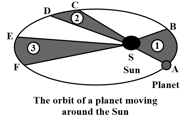
Kepler's third law states that the square of the period of revolution of a planet around the Sun is directly proportional to the cube of its mean _____ from the Sun.
Observe the given figure showing the orbit of a planet moving around the Sun and fill in the blank given below:
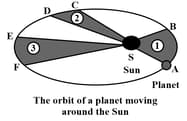
Kepler's second law states that the line joining the planet and the Sun sweeps equal areas in equal intervals of _____.
Observe the given figure showing the orbit of a planet moving around the Sun and fill in the blank given below:
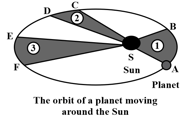
Kepler's first law states that the orbit of a planet is a/an _____ with the Sun at one of the foci.
The period and radius of a circular orbit of a planet about the sun are related by
If and are the angular momenta of two planets of masses and revolving around the sun in circular orbits of radii and , then is
The earth moves in an elliptical orbit with the sun at one of the foci as shown in the figure. Its kinetic energy is maximum at the point
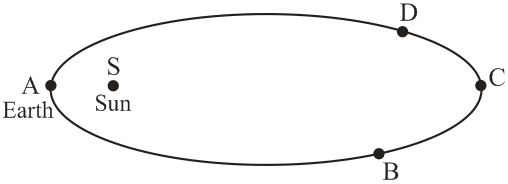
A planet moving around the sun sweeps are in days, in days and in days. Then the relation between and is:-
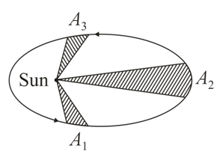
Earth revolves around Sun with time period of days. In the figure shown below, find the time taken (in days approximate to nearest integer) by the Earth to move from to in the path , if the eccentricity of ellipse is .
